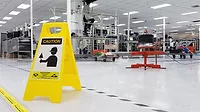The Case for Electrostatic Discharge (ESD) Flooring in Healthcare Facilities
.webp?t=1722264390)
By installing a static control flooring system, you unleash a multitude of benefits.
Photo: SelecTech.
When humans create static electricity in a healthcare setting bad things can happen. And these bad things can occur from doing such routine things as:
- Walking across a carpeted floor on a cold, dry day (5,000 volts)
- Pulling sheets off a bed (up to 60,000 volts)
- Opening a catheter package (up to 20,000 volts)
- Unrolling tape
- Wheeling a patient or bed across the floor
Now consider that human beings feel shock at 2,000 volts and experience pain at 5,000 volts. These sudden jolts can lead to several problems.
The What
- Damage and loss of function to equipment during patient care – An analysis of the U.S. Food and Drug Administration (FDA) Manufacturer and User Facility Device Experience (MAUDE) database from 2006 to 2016 revealed 1342 adverse device events related to ESD. Of these, 46 resulted in injury and five in deaths.
- Electronic records corruption – A study of a hospital in the northern tier of the U.S. found electrostatic discharge as the root cause of data loss from remote tablet computers.
- Shocks to staff – A new floor installed in a northeastern U.S. hospital resulted in significant static generation and numerous complaints from hospital staff.
- Contamination caused electrostatic attraction (ESA)– While no direct correlation has been documented between ESA and actual case studies of infection, some studies demonstrated increased attraction of bacteria to hospital aprons due to, you guessed it, static charges.
- Ignition of flammables - Controls for static discharges were originally implemented in hospitals due to the ignition of flammables such as anesthesia. While the use of flammable anesthesia has been significantly reduced, there are still occurrences of ignitions due to static discharges in healthcare environments. In one documented case, a woman suffered significant facial burns due to an ignition caused by Electrostatic discharge (ESD).
The Where
There’s a tendency to think static discharge might only be a factor in a hospital or clinic. Truth be told, ESD is an issue in all healthcare facilities, including:
- Hospitals
- Clinics and medical offices
- Nursing homes
- Mental health and addiction treatment centers
- Birth centers
- Hospice care facilities
- Dialysis facilities
- Imaging and radiology centers
- Orthopedic rehabilitation centers
- Long-term care hospitals
- Dental offices
- Medical research facilities
- Emergency and mobile medical units
The When
As stated above, humans feel shock at 2,000 volts and pain at 5,000 volts. The level of static charge of concern will depend on the risk involved. As previously stated, there are a number of potential risks in a healthcare setting associated with static discharges. The voltage levels of concern for these risks in a healthcare environment are:
- Damage and loss of function to equipment - 8,000 volts
- Electronic record corruption - 5,000 volts
- Involuntary reaction to shocks - 10,000 volts
- Contamination caused by ESA - 2,000 volts
What to do: Mitigation
ESD flooring solutions do not prevent static electricity. They can significantly reduce static electricity to safe levels. Generally, in a healthcare setting, if static charges on people can be kept below 2,000 volts, many of the hazards can be significantly reduced.
Those ESD flooring solutions can include:
- Vinyl tiles and sheets
- Interlocking tiles
- Rubber tiles and sheets
- Carpeting and Carpet Tiles
Controlling ESD in very sensitive environments, such as an electronics assembly area, requires the use of both flooring and ESD footwear so that charges built up on personnel can easily discharge through their shoes, into the floor and ultimately to ground. Fortunately, a healthcare setting, while being sensitive to ESD hazards, is not as sensitive as say an electronics assembly environment. So consequently, people don’t necessarily need to wear ESD footwear. Nor it is reasonable to think that ESD footwear would be worn in these environments by patients and staff. That’s why it’s important to look at how different ESD floors perform with regular footwear and ensure that they are capable of keeping voltages on people below 2000 volts.
There may be some areas of a healthcare facility, such as operating rooms, where there is more of a concern for the risks associated with static discharges. In these types of environments, it’s important to keep voltages much lower. To accomplish this, the flooring must be used in conjunction with ESD footwear so there is a good electrical connection between the person and the floor.
The Challenges
Most medical facilities are very active places so it can be difficult to schedule a time when ESD flooring can be installed. Particularly if the current floor needs to either be removed or requires significant prep work.
There are some interlocking ESD flooring products that can be installed over existing flooring with little or no floor prep and strategically put in around large equipment.
Learn more about specialty flooring solutions for commercial applications
Maintenance is another key factor as tiles in a medical facility need to be regularly cleaned to prevent the spread of germs. Some ESD products may require special cleaners, others might not. Also, it is important to not use conventional finishes on ESD flooring. They create an insulating layer on the floor and prevent it from working. Again, you need to do your research.
The Benefits
By installing a static control flooring system, you unleash a multitude of benefits, including:
- Broad protection – Flooring systems--particularly floor coverings, finishes, and coatings-- can be applied or installed throughout a healthcare facility. This provides a broad area of control rather than isolating control at individual stations.
- Improved mobility – With systems in place, staff have improved mobility and enhanced protection against nuisance or harmful shocks.
- Effective on personnel and mobile equipment – Flooring systems can help control static on people and carts or other similar mobile equipment.
- Electronics protection – Limiting voltage generation on staff and equipment helps protect sensitive electronic equipment from disruption, malfunctions, and/or failure caused by uncontrolled ESD
This proactive approach increases patient and staff safety, which in turn reduces their stress. Both help staff effectiveness, which can translate into:
- Patient healing
- Improved patient/family satisfaction
- Reduced staff turnover
- Reduced costs
Conclusion
When the static electricity in a medical office, examination room or lab is under control, it helps reduce the risks of shocks to personnel, disruption of data, malfunction of sensitive equipment, igniting flammables, and reducing contamination due to electrostatic attraction. This benefits the entire healthcare facility, making it safer and more reliable for the patients, staff and guests.
Looking for a reprint of this article?
From high-res PDFs to custom plaques, order your copy today!




